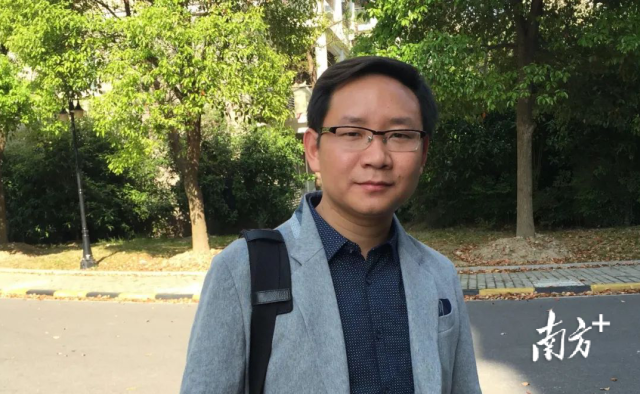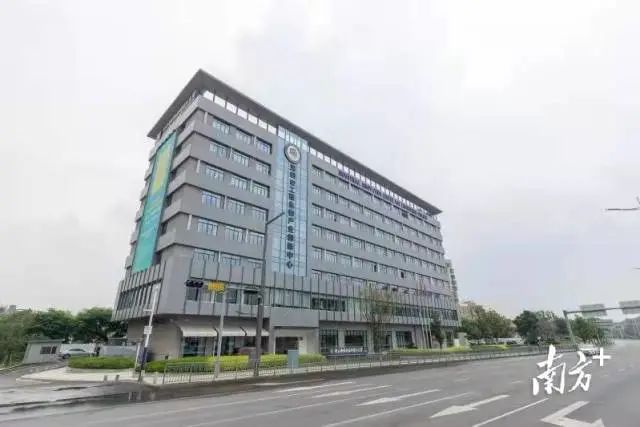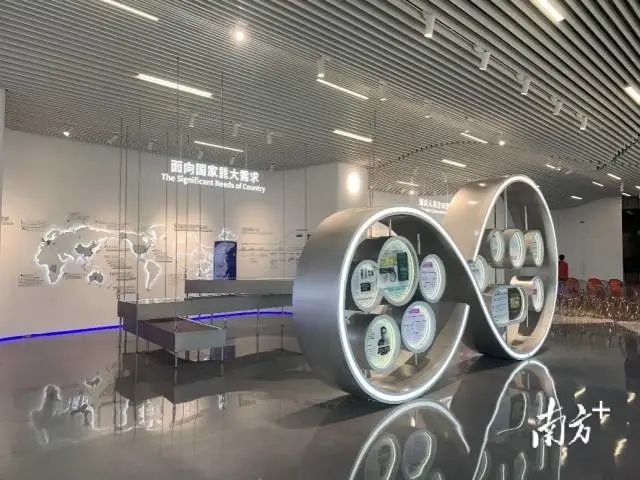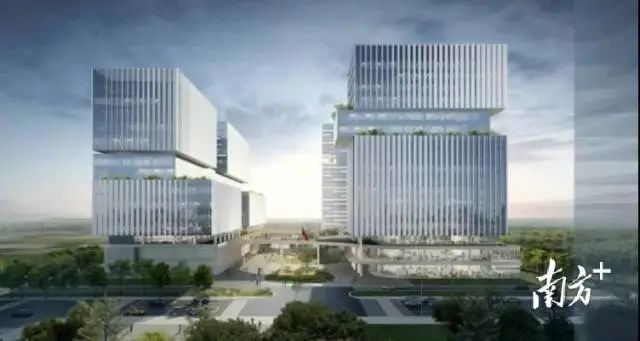
Unlike many researchers, Dr. Zhong Chao, who came to Shenzhen in 2020, has dual identities. He is not only the director of the Materials Synthetic Biology Center (referred to as the “MSBC”) of the Shenzhen Institutes of Advanced Technology, the Chinese Academy of Sciences but also the founder of Shenzhen PAM2L Biotechnologies Co., Ltd.
In the pioneering "Upstairs-Downstairs Innovation and Entrepreneurship Complex" in Shenzhen Engineering Biology Industry Innovation Center, the transition between his two roles can be measured in minutes.

The picture shows Zhong Chao, director of the Materials Synthetic Biology Center and founder of PAM2L Biotechnologies.

The picture shows Shenzhen Engineering Biology Industry Innovation Center, not far from which is the under-construction world's first major synthetic biology research infrastructure, Shenzhen Institute of Synthetic Biology, and Shenzhen Institutes of Advanced Technology, Chinese Academy of Sciences (tentatively referred to as "SIAT").
On a typical day, Zhong Chao often arrives at the Materials Synthesis Biology Center located on the 7th floor of the Innovation Center at around 8 am. He leads the research group in "0 to 1" and "1 to 10" original innovative R&D. When needed, he heads to PAM2L Biotechnologies on the 5th floor to guide the company's "10 to 100, to infinity" commercial applications. Doctoral students in the research group can also communicate with the company’s engineers anytime and anywhere, saving significant time and shortening the cycle from technology to application.
Dr. Zhong Chao graduated from Cornell University in New York Bay Area, USA, and completed postdoctoral work at University of Washington (Seattle) and MIT. In December 2021, Zhong Chao and his college classmate Cui Junfeng founded PAM2L Biotechnologies in Shenzhen. In just 9 months, they completed an angel round of financing, raising nearly 5 million USD, exclusively funded by 5Y Capital, which has previously invested in well-known companies like Ctrip, Xiaomi, Xpeng Motors, Kuaishou, and SenseTime.

The picture shows the exhibition hall on the first floor of Shenzhen Engineering Biology Industry Innovation Center. The infinite symbol indicates that the "upstairs-downstairs complex" has achieved the long-term goal of "from 1 to 10, then to ∞".
As we step into the Innovation Center of Shenzhen Guangming Science City, the infinite symbol several meters high in the exhibition hall on the first floor attracts our attention, and the words "Rather than wait for the future, create it!" exude passion and entrepreneurial spirit.
This "infinity" symbolizes one of Dr. Zhong's dreams. In recent years, his research group mainly focus on studies of protein adhesive materials and living functional materials. Could human tissue injuries, such as those to the skin, heart, arteries, and nerves, heal rapidly with a dab of "glue"? Zhong Chao's team has developed adhesive materials for human tissues, providing an effective way to realize this dream.
Dr. Zhong, unsatisfied with just the "0 to 1" and "1 to 10" research stages, had been contemplating entrepreneurship since 2017.
Shenzhen Institutes of Advanced Technology, Chinese Academy of Sciences not only encourages and supports young talents in innovation and entrepreneurship but also attracts young leaders and pioneering scientists from all over the world in this field, thanks to various entities such as the Major Scientific Infrastructure for Synthetic Biology Research, Institute of Synthetic Biology, and the Shenzhen Synthetic Biology Industry Innovation Center. All these factors prompted Dr. Zhong to choose Shenzhen in 2020, allowing him to successfully proceed with his long-contemplated entrepreneurial plans.
Today, within the Innovation Center building, startups are located from the 2nd to 5th floors, while the Institute of Synthetic Biology's research center and labs span from the 6th to 8th floors. Here, scientists in white and entrepreneurs in suits can exchange ideas, brainstorm, and collaboratively discuss potential paths and application scenarios for transforming relevant scientific technologies into industries. Apart from PAM2L Biotechnologies, over a dozen other companies have been set up here, with an evaluation of billions of yuan.
Outside the building, on the Gongchang Road spanning Shenzhen and Dongguan, construction vehicles are busy at work. Not far away, the world's first major scientific infrastructure for synthetic biology research and the country's first synthetic biology institute, namely the Institute of Synthetic Biology, SIAT are under construction.

The picture shows the renderings of the world's first major scientific infrastructure for synthetic biology research located in Guangming Science City, Shenzhen.
"After the synthetic biology large-scale facility is established, it will significantly boost scientific research efforts. Traditional 'manual operations' will transform into large-scale standardized, automated, and high-throughput machine operations, making experimentation more efficient. This will significantly reduce both the R&D costs and time for businesses,” Zhong Chao informed the reporters. In the Guangming District of Shenzhen, there is a convergence of education (SIAT's School of Synthetic Biology), platforms (major scientific infrastructure for synthetic biology research), research (Shenzhen Institute of Synthetic Biology), industry (Shenzhen Engineering Biology Industry Innovation Center, Synthetic Biology Industry Park), and capital (Synthetic Biology Industry Fund). This amalgamation is rapidly propelling the virtuous cycle of the synthetic biology industry ecosystem.
This virtuous cycle mirrors Shenzhen's endeavor in constructing a whole-process innovation ecosystem. In 2021, Shenzhen continuously refined its whole-process innovation ecosystem, emphasizing "fundamental research + technical breakthroughs + industrialization of results + technological finance + talent support", and made new strides in scientific and technological innovation. As countries worldwide race to stake their claim in emerging industries like synthetic biology, Shenzhen is swiftly building this whole-process innovation ecosystem.
In 2022, Shenzhen aims to leverage the combined effects of this innovation ecosystem, refine its technological innovation ecosystem, and introduce an Innovation Development “Five Major Actions” implementation plan. The goal is to rapidly enhance the "Five Powers", create the "Five Places", and establish the Greater Bay Area's comprehensive national science center, continually focusing on technological self-reliance and boosting supply penetration capabilities.
[Interview Notes] In recent years, there have been tremendous changes in Shenzhen's fundamental research field. The most evident change is the gathering of talents at home and abroad. In Shenzhen, researchers not only have platforms and funding but also find it easier to materialize their research outcomes, addressing their core issues, and adding to their sense of value.
Shenzhen persistently enhances its whole-process innovation ecosystem, focusing on "fundamental research + technical breakthroughs + industrialization of results + technological finance + talent support". As stipulated in the "Technology Innovation Regulations for the Shenzhen Special Economic Zone", the municipal government's investment in basic and applied research should be no less than 30% of the city-level R&D funds. It accelerates the construction of a comprehensive national science center, establishes world-class scientific infrastructure and research institutions, and attracts numerous international talents for innovation and entrepreneurship.
In Shenzhen's recent construction of the whole-process innovation ecosystem, fundamental research takes precedence. Du Zide, the advisor to the president of the Chinese University of Hong Kong (Shenzhen) who started working full-time in Shenzhen at the beginning of 2021, told the reporter: "Shenzhen's investment in fundamental research is very substantial. The establishment of ten major fundamental research institutions showcases Shenzhen's foresight and determination in this domain.”
Capitalizing on Shenzhen's industrial advantages in the IT sector over the years, represented as "from 1 to N", combined with the perfection of the "fundamental research + technical breakthroughs + industrialization of results + technological finance + talent support" innovation ecosystem, as the "from 0 to 1" innovation capability is constantly growing, and with foundational research and industrialization synergistically driving each other, it's believed that this city will continue to write many more "stories of spring".